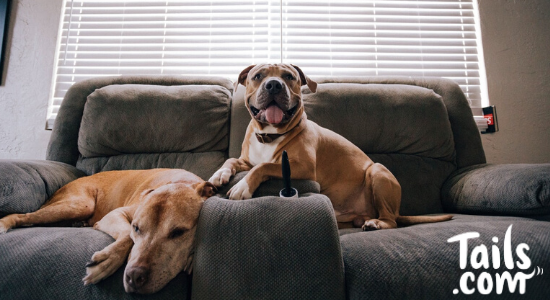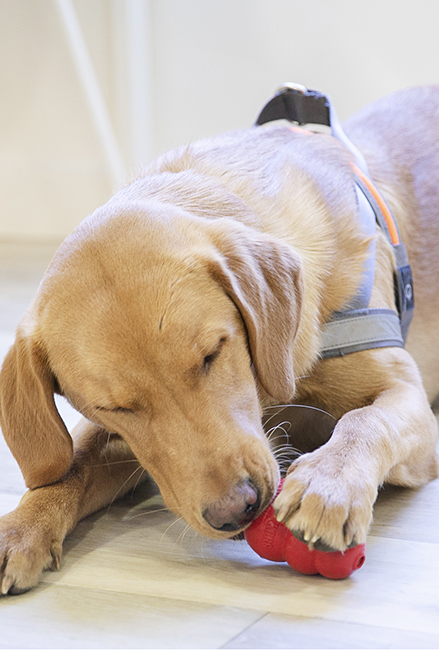If there’s one thing our dogs love most, it’s being by our side. When we need to leave, sometimes it’s not easy for both us and our canine friends. We’ve all felt the guilt after closing the door on those sad puppy dog eyes. We often find ourselves wondering what they get up to all day. It doesn’t have to be so difficult though. Here’s how to help your dog feel happy and relaxed alone, while giving you some peace of mind.
How long can a dog be left alone?

We’d all love to spend our days lounging around with our dogs, but unfortunately life can get in the way. Many of us work all day and there’s always the odd errand to run. Which means many dogs are home alone for many hours at a time.
Although some cope better when left alone, no dog should be left for longer than a few hours. Ideally no longer than 4 hours. So if you are out for 8 hours or more, it’s a good idea to have someone check in on your dog. Not only so they can relieve themselves, but to help break up their day too.
Dog breeds that can be left alone
All dogs are different, but there are some breeds that are known for tolerating alone time better than others. These breeds are typically less active and require less exercise. They’re often happy enough snoozing the day away on the sofa. The breeds below could be considered some of the best dog breeds for full time workers. However, all dogs have their own personalities, so only use these options as a guideline.
· Lurcher
· Basset Hound
· Chow Chow
· Basenji
· Boston Terrier
· Whippet
· Greyhound
· Shih Tzu
· Akita Inu
Related blog: What type of dog is right for me?
How to help your dog cope alone
Nobody wants to see their dog miserable or distressed when they leave. Especially if you return home to chewed up furniture, or you’ve been told your dog barks constantly. It’s a clear sign your dog is feeling lonely or anxious. Here are a few simple ways to help your dog feel more relaxed when you can’t be together.
Provide a safe space
Help your dog feel safe by preparing their very own chill out zone. Some dogs feel more secure when confined to a smaller area. Whether they have the run of the downstairs only, just one room in your home or a crate. When introduced in a positive way, a crate can feel like your dog’s safe bedroom space while you’re out.
It’s important your dog has access to their crate when you’re at home too though, so it doesn’t become a trigger for fear or anxiety. Make sure they have a soft bed to snuggle up in and access to fresh water. Background noise from a radio or tv can also ease the loneliness.
Introduce training
Get your dog used to being alone gradually with training. First leave your dog alone for a few minutes while you’re in another part of the home. Then start leaving the house for short periods at a time. Begin with two minutes, then five minutes and gradually increase the length of time you’re away.
Get your dog used to your leaving routines to desensitise them to potential triggers. If you always pick up your keys and coat to leave, do this multiple times throughout the day. This will help reduce the anxiety that can build up just before you leave the house.
Keep them entertained

Food puzzles and treat toys are a great distraction for your dog while you can’t be together. Offer your dog a Kong stuffed with their favourite food just before you leave. Mental stimulation will not only occupy your dog’s time, but it’ll wear them out so they’re ready to settle down for a nap.
If your dog is still struggling to cope on their own, your next best step is to get support from a qualified behaviourist. It’s important to make alone time a positive experience for your dog. The sooner we start our dogs on this path, the better your dog will cope.

Prior to my dog Daisy living with me, she lived with my mum & sister. My sister worked part time & my mum was retired and so Daisy always had company. Unfortunately my mum & sister died of Covid and I inherited Daisy. I don’t work because I have PTSD but occasionally I have to go out & Daisy barks for the entire time. I put dog calming music on YouTube and close the curtains and make her cosy . I give her a treat and leave but she barks constantly. Is there anything else i can do?
Hi Jane, We’re so sorry to hear of your loss – we’re thinking of you during this difficult time.
When it comes to helping with Daisy’s behaviour, we’d recommend speaking with a local dog behaviourist. They’ll be able to observe her in person, identify any specific triggers, and work with you to create a plan to help reduce her barking. Hopefully, this brings you both a bit more ease moving forward. Take care 💙
Hi when i leave my nearly 5 month old puppy moose and go out of eye view he starts crying and howling. Do you have any advice on this please?